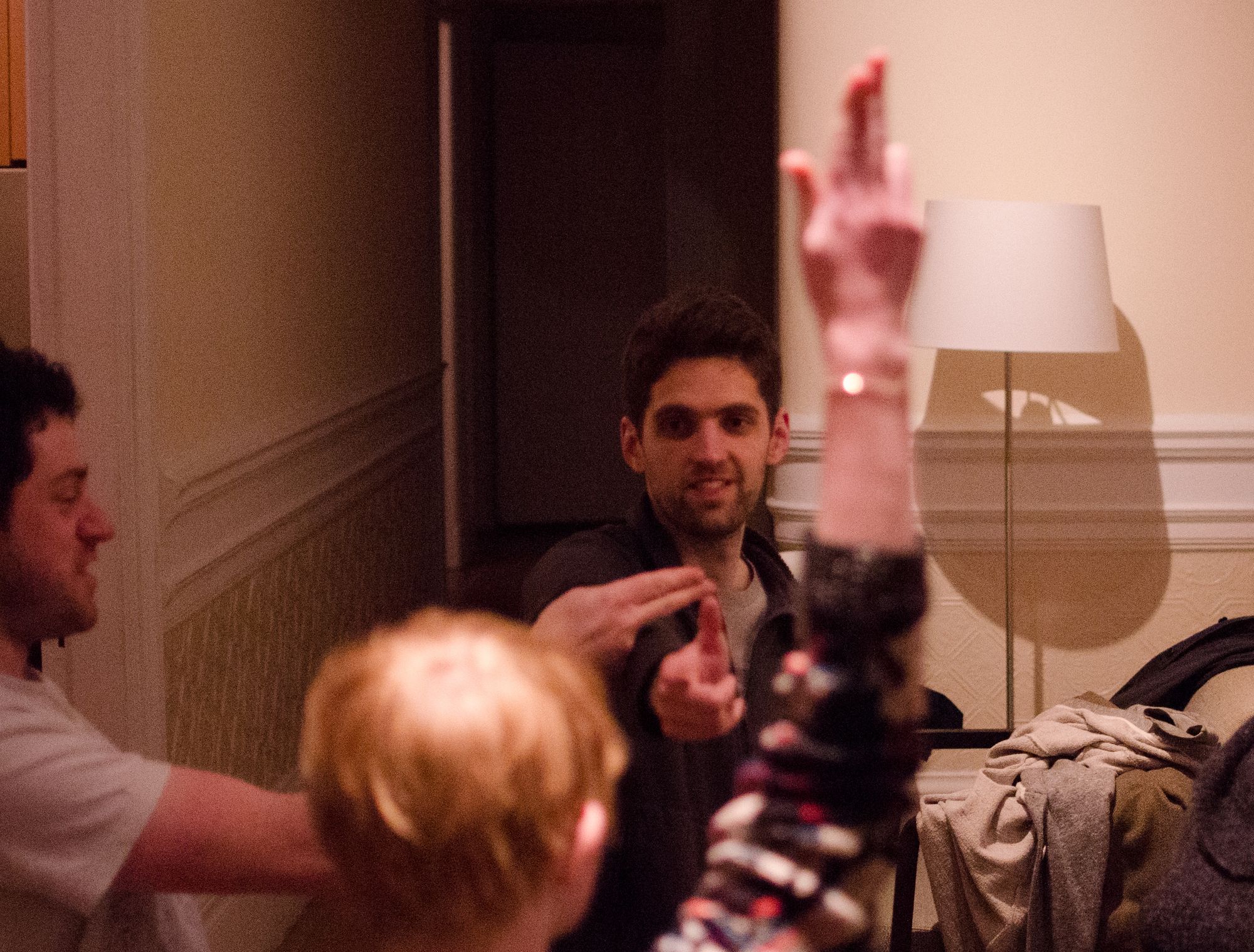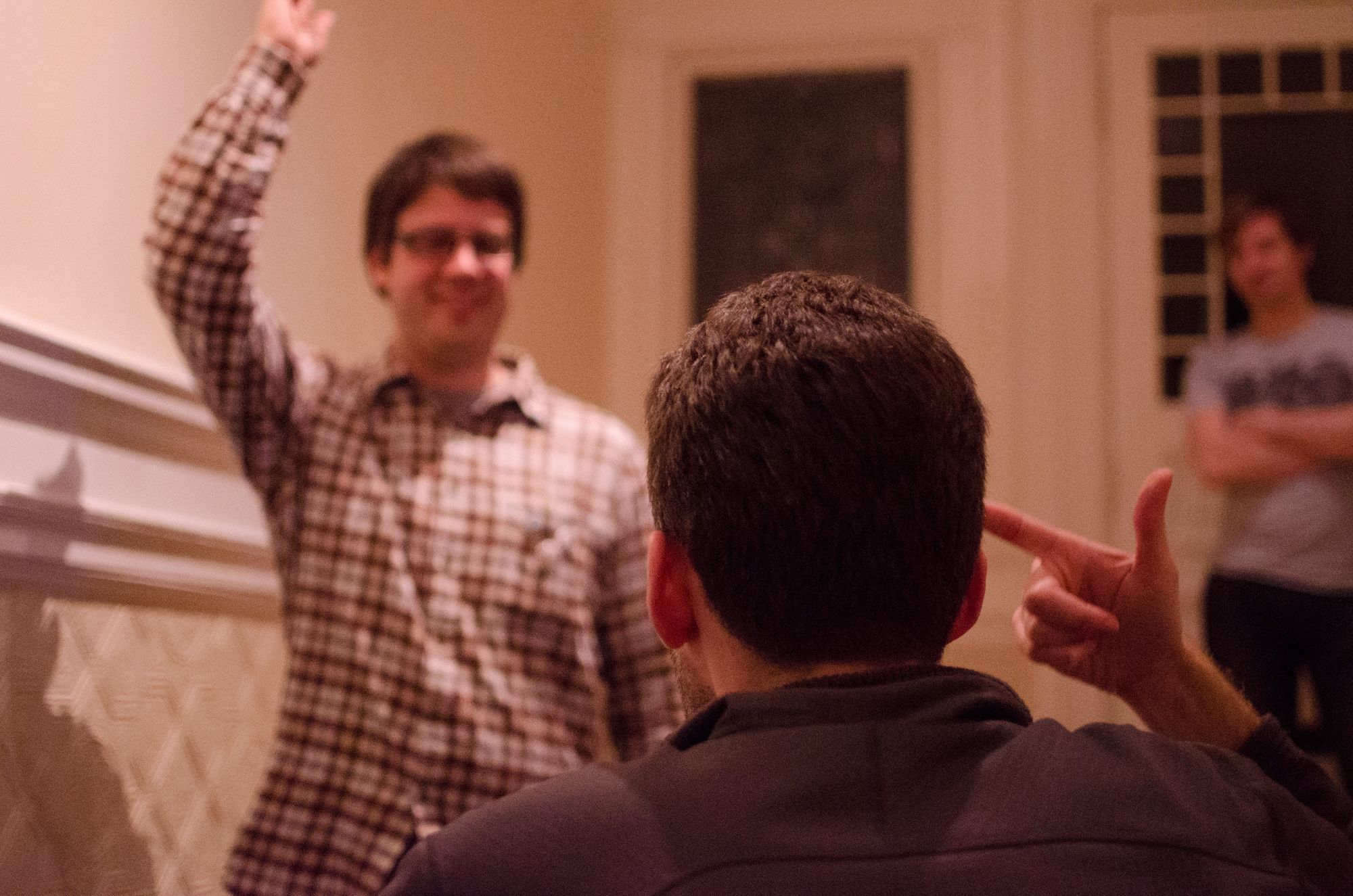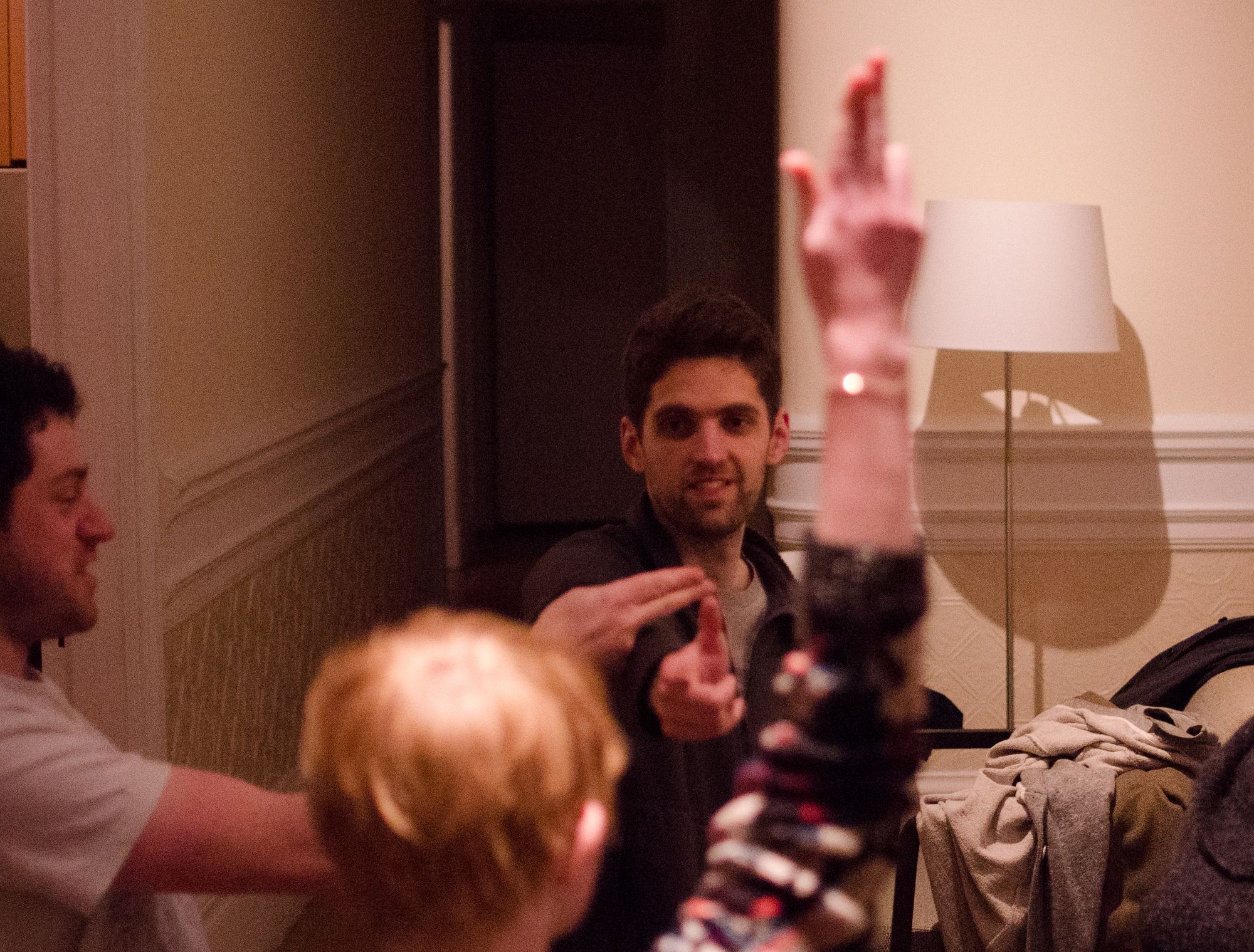
Redux: Folk Game — Standoff
This is the first post in a new series for the Die Gute Fabrik blog: Redux, from Game Designer and Co-Owner Douglas Wilson, takes some of his old game design posts from around 2012, published on our old blog, and re-posts them here, sometimes with additional commentary. Some of these posts have been linked from various places, and so we wanted to save them from the abyss!
[This post was originally published on October 9, 2012]
Content note: the game explained in this post uses both gun imagery and pointing 'finger guns’ at yourself as central mechanics.
Time to teach another one of my favorite folk/playground games!
Standoff is a simple game for two or more players – ideally a group of 5 to 10 people. It’s kind of like Rock-Paper-Scissors meets John Woo action flick.

The game and its variants go by many different names, but "Standoff" is the name that I use these days. I originally learned the game from my friend (and then-roommate) John Shedletsky. In this post, I’m going to explain several variations of the game, including my own favorite version.
Standoff – Version #1 (Recommended)
Players stand in a circle, facing each other. The game plays out as a series of rounds.
Before each round, each player pantomimes a pistol with one hand, placing it in an imaginary holster by their waist.
Then, on the count of three, all players simultaneously act out one of three choices:
1. Target an opponent – point your imaginary pistol at an opponent of your choice
2. Target yourself – point your imaginary pistol at yourself, touching your temple
3. Target nobody – point your imaginary pistol at the sky
Players then hold their pose while they collectively figure out who has been eliminated.
Targeting an opponent eliminates that opponent… unless they are pointing at themselves. In that case, your attack is reflected and you are eliminated. Pointing at yourself reflects all attacks on you, so you could potentially eliminate a whole slew of attackers at once.
If you point at yourself but nobody aims at you, you actually do end up attacking yourself and you get eliminated. But you do survive if you reflected any attackers.
If two players aim at one another, both players are eliminated. Note that it is also possible to be eliminated in a whole circular chain of people targeting one another.
Finally, pointing at the air serves as a kind of risk-averse move, played if you think all your opponents might try to target themselves.

The remaining players continue to the next round. The game continues until only one player remains. That player is the winner. Note that it’s possible for all players to get eliminated, in which case there are no winners!
As with most folk games, performative embellishments are encouraged for maximum fun. For example, my friends and I often pretend to reload our imaginary pistols before each round, with the appropriate gesture and sound effect and everything. Maybe that sounds goofy, but do what feels fun for your group.
Even within this particular version, there are a few house rules you might want to try. In my own personal favorite modification, each player gets two pistols, one on each hand. After all, it feels way more theatrical to wield dual pistols! In this mode, you can either aim both hands at the same target, or point them at different targets. We typically play that two pistols beats one pistol – both when targeting one another, and when targeting someone who is pointing at themselves.
Another house rule I often teach is giving each player two lives. When you get hit the first time, you go down to your knees, as if injured, visually signaling that you have one live left. Typically, we play you can only lose one life per round, even if you're targeted by multiple players. When you get hit again, you lie down on the ground, as if dead, now eliminated from the game. This adds a bit of performative flare to the game, and it also helps lengthen the duration of the game and adds the dramatic possibility of comeback victories.
Obviously, you could add all sorts of house rules, in many different combination. One way to combine the two house rules above is to make each player lose one of their pistols each time they are hit. This effectively gives each player two lives, but makes them less powerful after losing their first life.
Standoff – Version #2
This version of the game works similarly – players stand in a circle and try to be the last player standing. However, the three actions you can take differ in this version:
1. Attack – point your imaginary pistols at an opponent of your choice
2. Reload – holster your two pistols by you waist
3. Block – place your two arms in an x-shape across your chest
Note that in this version, you almost always play with dual pistols, because you’ll have to use both of your arms anyway for the block gesture. However, in the standard version, you can’t direct your two pistols at different targets or actions.
In this version, each pistol can only hold one pretend bullet. That’s why the reload action exists – you have to reload before you can attack again. Players themselves are responsible for remembering who is loaded and who isn’t.
Blocking, as is probably obvious, successfully deflects an attack. However, blocking does not reflect an attack, like shooting yourself does in Version #1 (see above).
The key decision in this version is gambling on when to reload. This choice is especially foregrounded when only two players remain, one loaded and the other not. The loaded player only wants to attack when they think the unloaded player will reload.
As in Variation #1, there are lots of possible variations here. Tim Garbos taught me one variation where reloading your gun three times gets you a bazooka! A bazooka can shoot through a block, but is beaten by a (faster) regular attack. In this variation, part of the challenge is to keep track of your opponents’ reload counts.
Comparing Version #1 vs Version #2
As I see it, a big shortcoming of Version #2 is having to remember who is loaded and who isn’t. In the chaos of competition, it can be easy to forget – even your own status! On the flip side, one might argue that this is an advantage – that keeping track of the current "game state" is one of the intended challenges of the game.
A common criticism of Version #1 is the lack of narrative plausibility. Why does targeting yourself reflect attacks? It doesn’t really make sense, and some players get hung up on that lack of coherence. That said, I personally feel like the strange game logic is actually an advantage. My friend Dick Hogg put it best:
"I actually like the wrongthink of it. [...] It makes no sense but it has the authentic feeling of weird warped logic that you get in kids games, playground games etc."
Another key selling point of Version #1 is that targeting yourself feels fun. Even just physically, holding up your finger to your temple makes the gambit seem all the gutsier, as if you were playing Russian Roulette or something.
However, my main advice on this point is to find a particular ruleset that you (and your friends) like best. Try improvising your own modifications! And let me know if you invent any particularly good ones.
2021 Afterword
I still play Standoff regularly, and it has become a major component of my undergraduate teaching. I'm a Senior Lecturer at RMIT University, in the Bachelor of Design (Games) program. I've been teaching our intro game design class for six years now, and every year I open the very first class with Standoff.
First, I teach the basic rules. Then I have the students try a couple different sets of house rules (two pistols, and then two lives - as described above). Finally, I have students work in groups to design their own house rules.
This is one of my favorite classroom activities, and I highly recommend it. First, Standoff functions as an effective social ice breaker. Second, the whole concept of "house rules" is a useful foundation upon which to build the entire ethos of the class. The goal is to remind the students that they aren't just players of games, they are also makers. The takeaway is that "making games" isn't restricted to the digital realm; playfulness is an attitude, a way of going about games and life.
Every year I'm surprised and impressed by my students' creativity. The groups usually present a very diverse range of modifications. We discuss how we can focus our modifications on physical theatricality, or strategy, or narrative.... or some combination thereof. There are many different pleasures of play/games!
This past year, because of the ongoing covid pandemic, I've had to move all my teaching online. But I decided I liked my Standoff activity too much to let it slip, so I needed to improvise a way to run it online.
Pretty quickly, I decided that it would be infeasible to play Standoff via videochat. In a game of simultaneous actions, you'd have to account for video lag. In addition, it would be pretty difficult to point at a particular person in the group!
Instead, I realized that I could teach Standoff as a card game, via my favorite website playingcards.io. Here's a look at the custom table I improvised:

My table template supports up to six players. I made a separate deck for each player, consisting of possible targets: nobody, and every player, including "myself". I also color-decorated the different players, for easy visual reference.
Sure, this version doesn't offer the same physical fun as pointing a finger pistol at an opponent. But it does allows me to cover all the key pedagogical takeaways online, in a format that suits the context.
This re-imagining of Standoff also affords new game design possibilities. The students quickly realized they could use the material properties of playingcards.io to inspire their house rules. Features like counters, random spinners, and tokens allow the students to modify Standoff in ways that would be infeasible in the physical in-person version.
If there's ever any interest in my table template, feel free to message me on Twitter, I'd be happy to share it more widely.